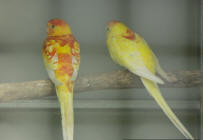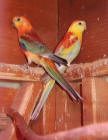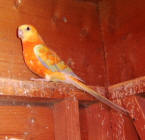|
BREEDS
& THEIR NEEDS
Redrumped Parakeets
( Psephotus haematonus)
 
General Information on the
Breed
- The Redrumped parrot is native to
South Eastern Australia.
- They were first bred in captivity by London
zoo in 1857.
- They mainly forage on the ground in small groups.
- All
Floor Foragers need regular worming programmes.
- They
tend to roost communally.
- So you could
keep a few pairs together out of the Breeding Season
- When NO
NESTBOXES in the Aviary.
- BUT NOT IN THE
BREEDING SEASON - ONE PAIR PER AVIARY ONLY!!
- They can be
quite vicious and aggressive if in a mixed Aviary or with
other Redrumps during breeding time.
- In the wild they breed from August to
January (Australia's Spring) in nests in holes or hollow branches of eucalyptus trees.
- They like to be close to water.
Description
Length: 270mm. Weight: Cock approx 70g, Hens approx 60g.
- The normal Red rump cock has a bright green head, neck and breast
which has a blue tint.
- The lower back is crimson and the abdomen is
yellow which fades to white with some green under the tail.
- The
wings are blue green in colour with yellow shoulder patches.
- The
outer webs of the flight feathers are blue and the tail is green
tinted with blue.
- The normal Red rump HEN is drab in comparison to
the male.
- It is mainly olive green with dull yellow on the neck and
breast.
- The shoulders bear a few blue feathers.
- The under the tail
is white with a tinge of very pale blue.
- The red patch on the rump is absent.
Diet
- Seeds including mixed millets, mixed
& plain canary seed, sunflower, groats
and grass seed.
- A "Budgie Tonic"; Budgie 50
50" or a Foreign Finch seed mix - add plain canary seed to
whichever you use.
- Greens such as lettuce,
sprouting seeds, chickweed, dandelion leaves and seeds (when
brown/ripe)
- Fruit including apples and
carrots etc.,
- Sweetcorn mixed with egg-food
with added Vitamins and minerals supplements in the Breeding
season.
Breeding
- Redrumped Parakeets breed well in captivity.
- For successful
breeding each pair should be segregated.
- i.e. ONLY One pair per
Aviary
- They like a deep Nest box approx
7 - 8"
square and 14 - 18" deep with a pop-hole just slightly
wider than the
bird itself, so that it's a snug fit (see Notes on
Nestboxes
).
- The Nestbox
should be placed as high in the Aviary as possible
- but with
sufficient room (2-3") from the roof- for the cockbird to
sit on top of the N.box while the Hen is brooding the eggs.
- Don't have the
Nestboxes facing South - too sunny and warm during the summer
- or North - a
bit too cool in the cooler months.
- south-East or
south-west are better.
- Don't have the
Nest box too big (base) as then the eggs can roll around and get
chilled and you could lose precious chicks
- Also, if too
big the chicks can also get chilled.
- Don't have too
much loose bedding - same problems the eggs/chicks can get
"Buried".
- Use
Easibed
or similar non-dusty wood chip for the base.
- You don't want them going down too early
esp. if the
weather is very cold, as you could end up with
Egg-binding or other
problems.
- The hen
generally lays between 5 - 7 eggs which are incubated from when the
second egg is laid.
- Incubation of the eggs is
19-20 days
- As soon as
the young are able to feeding themselves it is advisable to remove
them from their parents and house them separately.
- The cock is
likely to attack the youngsters, if they are left with the parents too
long.
-
I
suggest that you keep a very close eye on the Red-rumps as they
can be rather vicious towards other birds.
- It
is not unknown for cock birds to even kill their own sons
once they leave the nest.
-
The only way to get over this problem is to catch the youngsters
and place them in a box with a wire front on it and hang it in
the feeding quarters and the cock will feed through the wire,
-
if there is only a small clutch once
they leave the nest box catch cock and leave hen to finish
rearing.
- Birds are ready to breed from one year old onwards.
Preparation FOR BREEDING
- Have a look at
the
"Breeding Charts"
(Link on Home Page) and keep your Breeding records on this.
- You can either
print it out of transfer it to "Microsoft Word" and keep your
records on your computer.
- Then you know
when your first egg was laid,
- when -
approx - it's due and whether it hatches -
- when the
chick is rung, which leg, Ring details
- When the
Chick fledges
- What sex
it is
- Any
problems etc.,
- There are also
Lineage/Ancestry Charts, so that you can keep track of
who bred what and any problems or any good points you would like
to keep in your breeding lines.
FEEDING &
Preparation FOR BREEDING
- As the
Breeding Season approaches you need to make sure the birds have
been wormed
- Don't
leave this too late, as it can interfere with the chances of
the hen laying fertile eggs!
- See the
page on
Worming
for all the different types of Wormers available
- There
are Wormers in the water
-
Panacur Wormer (Liquid into Beak)
-
Panomec (Ivermectin based wormer - systemic i.e.
absorbed thru the skin) 1 drop on back of neck.
- You also need
to start thinking about "Upping" the Protein levels of the food
you are giving your birds.
- In the Wild
Birds have a lean time during winter, when food is difficult to
find and the quality is not good
- They do
not breed at these times, as they know that there would not
be enough quality food to feed their chicks.
- So, as
soon as the "rains" come along with the warmer Spring
weather - the lush vegetation starts to grow and this is the
time Birds in the wild will start to breed, as they then
instinctively know there will be enough good quality food to
feed and rear their chicks.
- In captivity
we simulate these conditions by feeding a basic "maintenance"
seed and water diet with some fruit and veg thru the winter
months.
- We want
our birds like "lean, mean machines" i.e. fit but not fat.
- Then as the
warmer weather and longer daylight hours come, we up the protein
and quality of food to simulate conditions in the wild, so the
bird is then stimulated into Breeding mode.
- So, we feed a
variety of high protein foods:
- Frozen
Sweetcorn (covered in boiling water to it's own level - put
in Microwave for 3-4 minutes and then drain water off.
- Add
Egg-food to the sweetcorn then add a sprinkle of Vit & min
supplement powder
- Mealworms
are a high protein food - not all birds will eat them - more
the Finch-types.
- Shredded
chicken / tuna added to the egg-food. (introduce slowly -
tiny amounts to start with).
- Lots of
fruit and veg (each bird has it's own preferences)
- A
Calcium supplement (Calicivet by
Bird
Care Co.) - follow the
instructions
- You can
over "Calicify" and end up with worse problems that those
you are trying to avert
- i.e.
prolapse due to egg being too difficult to expel
- Too thick
a shell + membrane then the chick can't "hatch" without
help.
- The hen bird
does draw on her own Calcium reserves to form her eggs so some
sort of supplementation is needed.
- Altho. in
nature the hen does increase her own calcium levels in
preparation for breeding but each time she lays an egg it
depletes her reserves.
- this is why
you should NEVER OVER-BREED.
- Smaller
Breeds should really only have 2 clutches per year
- More than
that is not adviseable.
- The parent
birds need a few months to recuperate and build up their
reserves etc., before the next Breeding Season.
- Cuttlefish,
grit, pink iodine blocks are all essential at breeding time.
- Be very
wary with Budgies - they DO NOT NEED extra Calcium - cuttlefish
is enough.
- If you
birds will eat pelleted Foods i.e. Kaytee/Pretty Bird etc., all
the better, as they are formulated to contain all the necessary
Protein, Vits & Mins for each species of bird.
- While the Hen
is sitting on the Eggs - the extra Protein Foods are withdrawn
and just a basic seed and Water.
-
The idea is
that the hen goes "broody" when she is sitting her eggs and
her metabolism slows down
-
(a bit
like hibernation but not asleep) so she doesn't need the
high protein foods -
-
just basic
seed and water to sustain her while she sits her eggs.
-
Once the first
chick is due to hatch hen once again you start to feed
the high protein foods,
-
cos the parents
need high protein foods to feed to the chicks to help them grow
properly and healthily.
-
Remember they grow
at a really rapid rate, so need all the nutritional help they
can get!
-
Usually a
soft-food such as Egg-food
-
there are lots
of Proprietory Brands of Egg-Food on the Market - some
better than others
-
I
personally like the Nutribird and Rob Harveys Moist Egg
Food
-
This helps
ensure they grow properly, quickly and healthily,
-
with good
feather quality and no bone deformities.
-
A poor diet
causes all sorts of problems in the chicks
-
inc.
splay
legs and poor feathers, beaks etc., as they grow so
quickly
Colour Mutations
- There are several mutations of
Red-rumped parakeets.
- Many of the
mutations can only be found in Australia and are not found
elsewhere.

- The commonest mutations include Lutino, yellow and olive
pied.
- All these mutations are found worldwide.
- Mutations such as
blue, platinum, cinnamon and opaline are common in Australia but
rarely found worldwide.
- The European blue is found both in Europe
and USA but is rare in Australia.
- Rare mutations such as red
suffusion, some of the fallows and grey are currently being
developed in Australia
- Lutino
Opaline Red Rumps
- INCUBATION: 19 - 20 days, depending on when they start to sit.
▲ Lutino
Opaline Red Rumps
- They lay
5-7 eggs on alternate days.
- FLEDGE
around 34-36 days
- Eyes fully opened around 12 days
- RING: around 12 - 14 days -
- RING SIZE:
N
☼
Added
Information from Members on their thoughts and experiences in
Keeping and Breeding Red Rumps
- The
Redrump got it's name because of the red patch
over the cock's rump and that's how you tell the cock
from hen.
- The
Hen's do not have the Red rump.
- All
the mutation cocks also have the Red rump.
- You
can breed the Red rump in a 3ft cage but you must have a
spare cage to put the young ones in when they are
feeding for themselves.
- I have
bred Rubino, Lutino and the Normal Red rumps in cages
but my cages were 4ft with the nest box on the outside
- I had
2 rounds a year.
John
These
beautiful, rare Red-rump mutations are owned and
being bred by one of our members!
click
"Thumbnails" to see bigger pictures
 |
 |
|
Orange Rubino Pastel Opaline Red Rump |
Rare Mutation - Orange Opaline Red rump |
^Top

|







